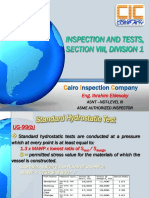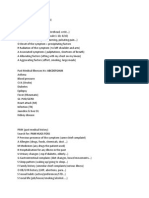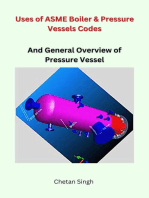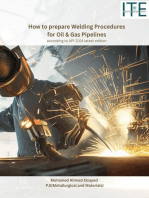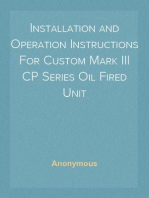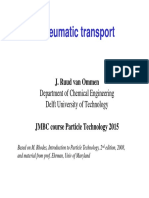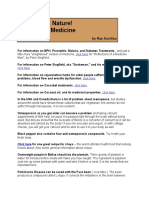0 ratings0% found this document useful (0 votes)
207 viewsUg-99 Standard Hydrostatic Test
Ug-99 Standard Hydrostatic Test
Uploaded by
Nícoli GaloThe document outlines hydrostatic testing requirements for vessels. It states that:
1) All vessels must undergo hydrostatic testing after fabrication and inspections, except those tested under other requirements.
2) Vessels designed for internal pressure must be tested at a pressure of at least 1.3 times the maximum allowable working pressure, accounting for material stress ratios and test conditions.
3) The hydrostatic test pressure must be high enough to check for leaks but not so high as to cause permanent distortion failures.
Copyright:
© All Rights Reserved
Available Formats
Download as DOCX, PDF, TXT or read online from Scribd
Ug-99 Standard Hydrostatic Test
Ug-99 Standard Hydrostatic Test
Uploaded by
Nícoli Galo0 ratings0% found this document useful (0 votes)
207 views7 pagesThe document outlines hydrostatic testing requirements for vessels. It states that:
1) All vessels must undergo hydrostatic testing after fabrication and inspections, except those tested under other requirements.
2) Vessels designed for internal pressure must be tested at a pressure of at least 1.3 times the maximum allowable working pressure, accounting for material stress ratios and test conditions.
3) The hydrostatic test pressure must be high enough to check for leaks but not so high as to cause permanent distortion failures.
Original Description:
ug 99
Original Title
UG99
Copyright
© © All Rights Reserved
Available Formats
DOCX, PDF, TXT or read online from Scribd
Share this document
Did you find this document useful?
Is this content inappropriate?
The document outlines hydrostatic testing requirements for vessels. It states that:
1) All vessels must undergo hydrostatic testing after fabrication and inspections, except those tested under other requirements.
2) Vessels designed for internal pressure must be tested at a pressure of at least 1.3 times the maximum allowable working pressure, accounting for material stress ratios and test conditions.
3) The hydrostatic test pressure must be high enough to check for leaks but not so high as to cause permanent distortion failures.
Copyright:
© All Rights Reserved
Available Formats
Download as DOCX, PDF, TXT or read online from Scribd
Download as docx, pdf, or txt
0 ratings0% found this document useful (0 votes)
207 views7 pagesUg-99 Standard Hydrostatic Test
Ug-99 Standard Hydrostatic Test
Uploaded by
Nícoli GaloThe document outlines hydrostatic testing requirements for vessels. It states that:
1) All vessels must undergo hydrostatic testing after fabrication and inspections, except those tested under other requirements.
2) Vessels designed for internal pressure must be tested at a pressure of at least 1.3 times the maximum allowable working pressure, accounting for material stress ratios and test conditions.
3) The hydrostatic test pressure must be high enough to check for leaks but not so high as to cause permanent distortion failures.
Copyright:
© All Rights Reserved
Available Formats
Download as DOCX, PDF, TXT or read online from Scribd
Download as docx, pdf, or txt
You are on page 1of 7
UG-99 STANDARD HYDROSTATIC TEST
(a) A hydrostatic test shall be conducted on all vessels
after
(1) all fabrication has been completed, except for operations
which could not be performed prior to the test
such as weld end preparation [see U-1(e)(1)(-a)], cosmetic
grinding on the base material which does not affect
the required thickness; and
(2) all examinations have been performed, except
those required after the test.
The completed vessels, except those tested in accordance
with the requirements of UG-100 and UG-101, shall
have satisfactorily passed the hydrostatic test prescribed
in this paragraph.
(b) Except as otherwise permitted in (a) above and
27-4, vessels designed for internal pressure shall be subjected
to a hydrostatic test pressure that at every point in
the vessel is at least equal to 1.3 times the maximum allowable
working pressure36 multiplied by the lowest
stress ratio (LSR) for the materials of which the vessel
is constructed. The stress ratio for each material is the
stress value S at its test temperature to the stress valueS at its design
temperature (see UG-21). Bolting shall not
be included in the determination of the LSR, except when
1.3 times the LSR multiplied by the allowable stress of the
bolt at its design temperature exceeds 90% of the bolt
material specified minimum yield strength at the test
temperature. All loadings that may exist during this test
shall be given consideration. The hydrostatic test pressure
reading shall be adjusted to account for any static
head conditions depending on the difference in elevation
between the chamber being tested and the pressure
gauge.
(c) A hydrostatic test based on a calculated pressure
may be used by agreement between the user and the
Manufacturer. The hydrostatic test pressure at the top
of the vessel shall be the minimum of the test pressures
calculated by multiplying the basis for calculated test
pressure as defined in 3-2 for each pressure element by
1.3 and reducing this value by the hydrostatic head on
that element. When this pressure is used, the Inspector
shall reserve the right to require the Manufacturer or
the designer to furnish the calculations used for determining
the hydrostatic test pressure for any part of the
vessel.
(d) The requirements of (b) above represent the minimum
standard hydrostatic test pressure required by this
Division. The requirements of (c) above represent a special
test based on calculations. Any intermediate value of
pressure may be used. This Division does not specify an
upper limit for hydrostatic test pressure. However, if
the hydrostatic test pressure is allowed to exceed, either
intentionally or accidentally, the value determined as prescribed
in (c) above to the degree that the vessel is subjected
to visible permanent distortion, the Inspector
shall reserve the right to reject the vessel.
(e) Combination units [see UG-19(a) and UG-21] shall
be tested by one of the following methods.
(1) Independent Pressure Chambers. Pressure chambers
of combination units that have been designed to operate
independently shall be hydrostatically tested as
separate vessels, that is, each chamber shall be tested
without pressure in the adjacent chamber. If the common
elements of a combination unit are designed for a larger
differential pressure than the higher maximum allowable
working pressure to be marked on the adjacent chambers,
the hydrostatic test shall subject the common elements
to at least their design differential pressure,
corrected for temperature as in (b) above, as well as meet
the requirements of (b) or (c) above for each independent
chamber.
(2) Dependent Pressure Chambers. When pressure
chambers of combination units have their common elements
designed for the maximum differential pressure
that can possibly occur during startup, operation, and
shutdown, and the differential pressure is less than the
higher pressure in the adjacent chambers, the
commonelements shall be subjected to a hydrostatic test pressure
of at least 1.3 times the differential pressure to be marked
on the unit, corrected for temperature as in (b).
Following the test of the common elements and their
inspection as required by (g) below, the adjacent chambers
shall be hydrostatically tested simultaneously [see
(b) or (c) above]. Care must be taken to limit the differential
pressure between the chambers to the pressure used
when testing the common elements.
The vessel stamping and the vessel Data Report must
describe the common elements and their limiting differential
pressure. See UG-116(j) and UG-120(b).
(f) Single‐wall vessels and individual pressure chambers
of combination units designed for vacuum only
(MAWP less than or equal to zero) shall be subjected to
either
(1) an internal hydrostatic pressure test in accordance
with UG-99, or a pneumatic pressure test in accordance
with UG-100. The applied test pressure shall be not
less than 1.3 times the specified external design pressure;
or
(2) a vacuum test conducted at the lowest value of
specified absolute internal design pressure. In conjunction
with the vacuum test, a leak test shall be performed
following a written procedure complying with the applicable
technical requirements of Section V, Article 10 for
the leak test method and technique specified by the user.
Leak testing personnel shall be qualified and certified as
required by T-120(e) of Section V, Article 1.
(g) Following the application of the hydrostatic test
pressure, an inspection shall be made of all joints and connections.
This inspection shall be made at a pressure not
less than the test pressure divided by 1.3. Except for leakage
that might occur at temporary test closures for those
openings intended for welded connections, leakage is not
allowed at the time of the required visual inspection.
Leakage from temporary seals shall be directed away so
as to avoid masking leaks from other joints.
The visual inspection of joints and connections for
leaks at the test pressure divided by 1.3 may be waived
provided:
(1) a suitable gas leak test is applied;
(2) substitution of the gas leak test is by agreement
reached between Manufacturer and Inspector;
(3) all welded seams that will be hidden by assembly
are given a visual examination for workmanship prior to
assembly;
(4) the vessel will not contain a “lethal” substance.
(h) Any nonhazardous liquid at any temperature may
be used for the hydrostatic test if below its boiling point.
Combustible liquids having a flash point less than 110°F
(43°C), such as petroleum distillates, may be used only
for near atmospheric temperature tests. It is recommended
that the metal temperature during hydrostatic
test be maintained at least 30°F (17°C) above the minimum
design metal temperature, but need not exceed
120°F (48°C), to minimize the risk of brittle fracture.
[See UG-20 and Figure UCS-66.2, Note (6).] The test pressure
shall not be applied until the vessel and its contents
are at about the same temperature. If the test temperature
exceeds 120°F (48°C), it is recommended that inspection
of the vessel required by (g) above be delayed
until the temperature is reduced to 120°F (48°C) or less.
CAUTION: A small liquid relief valve set to 11/3 times the test
pressure is recommended for the pressure test system, in case
a vessel, while under test, is likely to be warmed up materially
with personnel absent.
(i) Vents shall be provided at all high points of the vessel
in the position in which it is to be tested to purge possible
air pockets while the vessel is filling.
(j) Before applying pressure, the test equipment shall
be examined to see that it is tight and that all lowpressure
filling lines and other appurtenances that should
not be subjected to the test pressure have been
disconnected.
(k) Painting and Coating
(1) Unless permitted by the user or his designated
agent, pressure-retaining welds of vessels shall not be
painted or otherwise coated either internally or externally
prior to the pressure test. [See UCI-99(b) and
UCD-99(b).]
(2) When painting or coating prior to the hydrostatic
test is permitted, or when internal linings are to be applied,
the pressure-retaining welds shall first be leak
tested in accordance with ASME Section V, Article 10.
Such a test may be waived with the approval of the user
or his designated agent.
(3) Vessels for lethal service [see UW-2(a)] shall not
be painted or otherwise coated or lined either internally
or externally prior to the hydrostatic pressure test.
(a) Um teste hidrostático deve ser realizado em todas as embarcações
depois (1) toda a fabricação foi concluída, exceto as operações que
não pode ser realizado antes do teste como preparação da
extremidade da solda [ver U-1(e)(1)(-a)], cosméticos moagem no
material de base que não afeta a espessura necessária; e (2) todos os
exames foram realizados, exceto os necessários após o teste. As
embarcações concluídas, exceto aquelas testadas de acordo com com
os requisitos de UG-100 e UG-101, deve passaram satisfatoriamente
no teste hidrostático prescrito neste parágrafo. (b) Exceto conforme
permitido em (a) acima e 27-4, os vasos projetados para pressão
interna devem ser submetidos a uma pressão de teste hidrostático que
em cada ponto a embarcação é pelo menos igual a 1,3 vezes o
máximo permitido pressão de trabalho36 multiplicada pelo menor
relação de tensão (LSR) para os materiais dos quais o vaso É
construído. A razão de tensão para cada material é a valor de tensão
S em sua temperatura de teste para os valores de tensão S em seu
projeto temperatura (ver UG-21). O aparafusamento não deve ser
incluído na determinação do LSR, exceto quando 1,3 vezes o LSR
multiplicado pela tensão admissível do parafuso em sua temperatura
de projeto excede 90% do parafuso material limite de escoamento
mínimo especificado no teste temperatura. Todas as cargas que
possam existir durante este teste deve ser considerada. A pressão de
teste hidrostático a leitura deve ser ajustada para levar em conta
qualquer estática condições da cabeça dependendo da diferença de
elevação entre a câmara que está sendo testada e a pressão medidor.
(c) Um teste hidrostático baseado em uma pressão calculada pode ser
usado por acordo entre o usuário e o Fabricante. A pressão de teste
hidrostático no topo do recipiente deve ser o mínimo das pressões de
ensaio calculado multiplicando a base para o teste calculado pressão
conforme definido em 3-2 para cada elemento de pressão por 1.3 e
reduzindo este valor pela carga hidrostática esse elemento. Quando
esta pressão é usada, o Inspetor reserva-se o direito de exigir que o
Fabricante ou o projetista para fornecer os cálculos usados para
determinar a pressão de teste hidrostático para qualquer parte do
embarcação. (d) Os requisitos de (b) acima representam o mínimo
pressão de teste hidrostático padrão exigida por este Divisão. Os
requisitos de (c) acima representam uma teste baseado em cálculos.
Qualquer valor intermediário de pressão pode ser usada. Esta Divisão
não especifica um limite superior para a pressão de teste hidrostático.
No entanto, se a pressão de teste hidrostático pode exceder, seja
intencional ou acidentalmente, o valor determinado conforme prescrito
em (c) acima na medida em que a embarcação é submetida à
distorção permanente visível, o Inspetor reserva-se o direito de rejeitar
o navio. (e) As unidades combinadas [ver UG-19(a) e UG-21] devem
ser testado por um dos seguintes métodos. (1) Câmaras de Pressão
Independentes. Câmaras de pressão de unidades combinadas que
foram projetadas para operar independentemente devem ser testados
hidrostaticamente como recipientes separados, ou seja, cada câmara
deve ser testada sem pressão na câmara adjacente. Se o comum
elementos de uma unidade de combinação são projetados para uma
maior pressão diferencial do que o máximo mais alto permitido
pressão de trabalho a ser marcada nas câmaras adjacentes, o teste
hidrostático deve submeter os elementos comuns para pelo menos
sua pressão diferencial de projeto, corrigido para a temperatura como
em (b) acima, bem como atender os requisitos de (b) ou (c) acima
para cada câmara. (2) Câmaras de Pressão Dependentes. Quando a
pressão câmaras de unidades combinadas têm seus elementos
comuns projetado para a pressão diferencial máxima que podem
ocorrer durante a inicialização, operação e desligamento, e a pressão
diferencial é menor do que a pressão mais alta nas câmaras
adjacentes, os elementos comuns devem ser submetidos a uma
pressão de teste hidrostático de pelo menos 1,3 vezes a pressão
diferencial a ser marcada na unidade, corrigida para a temperatura
como em (b). Após o teste dos elementos comuns e sua inspeção
conforme exigido por (g) abaixo, as câmaras adjacentes devem ser
testadas hidrostaticamente simultaneamente [ver (b) ou (c) acima].
Cuidados devem ser tomados para limitar a diferencial pressão entre
as câmaras para a pressão utilizada ao testar os elementos comuns.
O carimbo da embarcação e o Relatório de Dados da embarcação
devem descrever os elementos comuns e seu diferencial limitante
pressão. Ver UG-116(j) e UG-120(b). (f) Vasos de parede simples e
câmaras de pressão individuais de unidades combinadas projetadas
apenas para vácuo (MAWP menor ou igual a zero) deve ser
submetido a qualquer (1) um teste de pressão hidrostática interna de
acordo com UG-99, ou um teste de pressão pneumática de acordo
com UG-100. A pressão de teste aplicada não deve ser menos de 1,3
vezes a pressão de projeto externa especificada; ou (2) um teste de
vácuo realizado no valor mais baixo de pressão de projeto interna
absoluta especificada. Em conjunto com o teste de vácuo, um teste de
vazamento deve ser realizado seguindo um procedimento escrito em
conformidade com os requisitos técnicos da Seção V, Artigo 10 para o
método de teste de vazamento e a técnica especificada pelo usuário.
O pessoal de teste de vazamento deve ser qualificado e certificado
como exigido pelo T-120(e) da Seção V, Artigo 1. (g) após a aplicação
do teste hidrostático pressão, deve ser feita uma inspeção de todas as
juntas e conexões. Esta inspeção deve ser feita a uma pressão não
menor que a pressão de teste dividida por 1,3. Exceto por vazamento
que podem ocorrer em encerramentos de teste temporários para
aquelas aberturas destinadas a conexões soldadas, o vazamento não
é permitido no momento da inspeção visual exigida. O vazamento de
vedações temporárias deve ser direcionado para evitar vazamentos de
outras juntas. A inspeção visual de juntas e conexões para
vazamentos na pressão de teste dividido por 1,3 podem ser
dispensados forneceu: (1) é aplicado um teste de vazamento de gás
adequado; (2) a substituição do teste de vazamento de gás é por
acordo alcançado entre o Fabricante e o Inspetor; (3) todas as
costuras soldadas que serão ocultadas pela montagem são
submetidas a um exame visual de mão de obra antes de conjunto; (4)
o recipiente não conterá uma substância “letal”. (h). Qualquer líquido
não perigoso a qualquer temperatura pode ser usada para o teste
hidrostático se estiver abaixo de seu ponto de ebulição. Líquidos
combustíveis com ponto de fulgor menor que 110°F (43°C), como
destilados de petróleo, só podem ser usados para testes de
temperatura próxima à atmosférica. É recomendado que a
temperatura do metal durante a hidrostática teste seja mantido pelo
menos 30°F (17°C) acima do mínimo temperatura do metal de projeto,
mas não precisa exceder 120°F (48°C), para minimizar o risco de
fratura frágil. [. Consulte UG-20 e Figura UCS-66.2, Nota (6). ] A
pressão de teste não deve ser aplicada até que o recipiente e seu
conteúdo estão aproximadamente na mesma temperatura. Se a
temperatura de teste excede 120°F (48°C), é recomendado que a
inspeção da embarcação exigida por (g) acima seja adiada até que a
temperatura seja reduzida para 120°F (48°C) ou menos. CUIDADO:
Uma pequena válvula de alívio de líquido ajustada para 11/3 vezes o
teste pressão é recomendado para o sistema de teste de pressão, no
caso uma embarcação, enquanto em teste, é susceptível de ser
aquecido materialmente com o pessoal ausente. (i). Devem ser
fornecidos respiradouros em todos os pontos altos da embarcação na
posição em que deve ser testado para eliminar possíveis bolsas de ar
durante o enchimento do recipiente. (j) Antes de aplicar pressão, o
equipamento de teste deve ser examinado para ver se está apertado e
se todos os pontos de baixa pressão linhas de enchimento e outros
acessórios que devem não ser submetido à pressão de teste foram
desconectados. (k) Pintura e Revestimento (1) A menos que permitido
pelo usuário ou seu designado agente, as soldas de retenção de
pressão dos vasos não devem ser pintados ou revestidos de outra
forma interna ou externamente antes do teste de pressão. [Ver UCI-
99(b) e UCD-99(b).] (2) Ao pintar ou revestir antes da hidrostática
teste é permitido, ou quando os revestimentos internos devem ser
aplicados, as soldas de retenção de pressão devem primeiro ser
vazadas testado de acordo com ASME Seção V, Artigo 10. Tal teste
pode ser dispensado com a aprovação do usuário ou seu agente
designado. (3) Embarcações para serviço letal [ver UW-2(a)] não
devem ser pintados ou revestidos ou forrados internamente ou
externamente antes do teste de pressão hidrostática.
You might also like
- Hydrostatic Test Procedure PDFDocument2 pagesHydrostatic Test Procedure PDFLuis Pullas87% (45)
- 737 Performance Reference Handbook - EASA EditionFrom Everand737 Performance Reference Handbook - EASA EditionRating: 4.5 out of 5 stars4.5/5 (3)
- Hydrostatic Test Procedure Storage TankDocument15 pagesHydrostatic Test Procedure Storage TankYuwantoniAl75% (4)
- QC's SOPDocument11 pagesQC's SOPDavid See100% (1)
- ASME VIII Div. 1 - 6 Pressure TestingDocument11 pagesASME VIII Div. 1 - 6 Pressure TestingYoucef ChorfaNo ratings yet
- Hydrostatic Test ProcedureDocument9 pagesHydrostatic Test ProcedureMohammed Kamal86% (14)
- ASME VIII Div. 1 - 1 Internal PressureDocument90 pagesASME VIII Div. 1 - 1 Internal Pressureعصمت ضيف الله83% (12)
- Adnexal Masses - Ovarian Cysts (2008)Document23 pagesAdnexal Masses - Ovarian Cysts (2008)Michelle Fynes100% (1)
- Science: Common Atmospheric PhenomenaDocument33 pagesScience: Common Atmospheric PhenomenaMelanie Tagudin Trinidad80% (5)
- Mnemonics For Clinical ExamDocument20 pagesMnemonics For Clinical ExamDrAmeen1976100% (3)
- Esquema SamsungDocument60 pagesEsquema SamsungCleumo BarrosNo ratings yet
- Hydrostatic Test of Pressure VesselsDocument2 pagesHydrostatic Test of Pressure Vesselsعزت عبد المنعم100% (2)
- Standard Procedure For Hydrotest As Per Asme?Document4 pagesStandard Procedure For Hydrotest As Per Asme?Faraz ArshadNo ratings yet
- Standard Procedure For Hydrotest As Per Asme?Document4 pagesStandard Procedure For Hydrotest As Per Asme?Faraz ArshadNo ratings yet
- UG-100 Pneumatic TestDocument2 pagesUG-100 Pneumatic TestInaamNo ratings yet
- OKITP01 - PruebaPresión Rev.1Document13 pagesOKITP01 - PruebaPresión Rev.1Hugo Fiusa AlvarezNo ratings yet
- Pressure TestingDocument14 pagesPressure TestingWeld Bro Sandeep100% (2)
- Inspection and Tests: ASME Section VIII, Division 1Document16 pagesInspection and Tests: ASME Section VIII, Division 1Muhamed MahmoudNo ratings yet
- Asme Ccase - 2046Document2 pagesAsme Ccase - 2046ADAMJSRAONo ratings yet
- ASME VIII Div. 1 - 6 Pressure TestingDocument26 pagesASME VIII Div. 1 - 6 Pressure Testingعصمت ضيف الله75% (4)
- Article T-3 Hydrostatic Tests: Licensed by Information Handling Services Licensed by Information Handling ServicesDocument2 pagesArticle T-3 Hydrostatic Tests: Licensed by Information Handling Services Licensed by Information Handling Servicesbgonzalez1981No ratings yet
- Testing: II.1. Limitations On PressureDocument10 pagesTesting: II.1. Limitations On Pressureகோகுல் இராNo ratings yet
- Hydrostatic Test Procedure For Vessel-BHTV006Document11 pagesHydrostatic Test Procedure For Vessel-BHTV006purnawanNo ratings yet
- ASME Code Section VIII Pressure TestsDocument3 pagesASME Code Section VIII Pressure TestsAngga100% (1)
- 1.1 PmtaDocument2 pages1.1 Pmtagabao123No ratings yet
- 08 Hydrostatic Test Procedure Section I OKDocument9 pages08 Hydrostatic Test Procedure Section I OKEduardo GarciaNo ratings yet
- Hydrostatic Testing ProcedureDocument3 pagesHydrostatic Testing Procedurebala.mNo ratings yet
- IP50 - Pressure Testing of Refinery EquipmentDocument8 pagesIP50 - Pressure Testing of Refinery EquipmentsajiNo ratings yet
- Hydrostatic Testing: 1 GeneralDocument9 pagesHydrostatic Testing: 1 GeneralPaolita Auza BalderramaNo ratings yet
- Especificaciones DOT SP12277 2014Document9 pagesEspecificaciones DOT SP12277 2014usamazarifehNo ratings yet
- 510 Daily PointsDocument12 pages510 Daily Pointscengiz88No ratings yet
- Industrial Process EquipmentDocument60 pagesIndustrial Process Equipmentglazetm100% (1)
- Tank Testing - ABS 3.7.1Document6 pagesTank Testing - ABS 3.7.1Siadi MulyantoNo ratings yet
- ROCEDURE - INSPECTION & TEST ValvesDocument10 pagesROCEDURE - INSPECTION & TEST Valvessabes26No ratings yet
- Rules-56-Under-Sec-31-Full-Factories ActDocument6 pagesRules-56-Under-Sec-31-Full-Factories ActGopal RamalingamNo ratings yet
- Open Book PortionDocument6 pagesOpen Book Portionvishal bailurNo ratings yet
- 510 PC Oct04 Qar-Mid Closed PSJDocument12 pages510 PC Oct04 Qar-Mid Closed PSJCss SfaxienNo ratings yet
- Inspection and Tests: ASME Section VIII, Division 1Document16 pagesInspection and Tests: ASME Section VIII, Division 1Mahmoud TolbaNo ratings yet
- Vessel Pressure TestingDocument3 pagesVessel Pressure Testingalokbdas100% (1)
- Load CasesDocument15 pagesLoad CasesVishnu Menon100% (2)
- SPC-0804.02-96.58 Rev D2 Hydrostatic Pressure Testing of PipingDocument23 pagesSPC-0804.02-96.58 Rev D2 Hydrostatic Pressure Testing of Pipingsdb91No ratings yet
- Hydrotesting of ShellDocument4 pagesHydrotesting of Shellmsaqibraza93No ratings yet
- TESTINGDocument7 pagesTESTINGSoner Kulte100% (1)
- FAT ProcedureDocument7 pagesFAT ProcedureOlek TybińskiNo ratings yet
- Pressure Testing of Pressure VesselDocument3 pagesPressure Testing of Pressure VesselAriq FauzanNo ratings yet
- Content.: Provision Is J)Document1 pageContent.: Provision Is J)Antonio Mezzoprete100% (1)
- 345 Testing THDocument6 pages345 Testing THDjeisonSeccoNo ratings yet
- Abs Rules For Building and Classing Steel Barges Abs Rcn7Document7 pagesAbs Rules For Building and Classing Steel Barges Abs Rcn7georgekc77100% (1)
- Test API RP 1111Document2 pagesTest API RP 1111Nguyễn QuânNo ratings yet
- Hydrotest QI304-sampleDocument3 pagesHydrotest QI304-sampleHanuman Rao100% (1)
- Hose Test ProcedureDocument6 pagesHose Test ProcedureafandybaharuddinNo ratings yet
- ASME SEC VIII DIV-1 Boiler Pressure Vessel Code 2013 Rules For Construction of Pressure Vessels by American Society of Mechanical Engineers (Z-Lib - Org) (156-160)Document5 pagesASME SEC VIII DIV-1 Boiler Pressure Vessel Code 2013 Rules For Construction of Pressure Vessels by American Society of Mechanical Engineers (Z-Lib - Org) (156-160)Rafael Esteban BarriaNo ratings yet
- Dot SP 11808Document8 pagesDot SP 11808روشان فاطمة روشانNo ratings yet
- 1.hydrostatic Test and Flushing (R2)Document19 pages1.hydrostatic Test and Flushing (R2)sethu109190% (10)
- T. in The Case of Current-Limiting Fuses, The Maximum Arc Energy May Occur at Current LevelsDocument20 pagesT. in The Case of Current-Limiting Fuses, The Maximum Arc Energy May Occur at Current Levelsnandana_849065438No ratings yet
- Viii 1 Ug 20Document1 pageViii 1 Ug 20SonyAcerNo ratings yet
- Proposed Hydro Test Procedures For ValvesDocument8 pagesProposed Hydro Test Procedures For ValvesNilesh Ghodekar100% (1)
- Attachment - 5 (ZPEC-0414-HP Rev. 0) Hydro ProcedureDocument4 pagesAttachment - 5 (ZPEC-0414-HP Rev. 0) Hydro ProcedureMohammad MushtaqNo ratings yet
- Para. 345.3.3 (C) Para. 345 Appendix X Para. 345.8: 345.3 Preparation For Leak TestDocument2 pagesPara. 345.3.3 (C) Para. 345 Appendix X Para. 345.8: 345.3 Preparation For Leak TestANIL PLAMOOTTILNo ratings yet
- File 985Document4 pagesFile 985Binay K SrivastawaNo ratings yet
- Estimator's Piping Man-hours Tool: Estimating Man-hours for Carbon Steel Process Piping Projects. Manual of Man-hours, ExamplesFrom EverandEstimator's Piping Man-hours Tool: Estimating Man-hours for Carbon Steel Process Piping Projects. Manual of Man-hours, ExamplesNo ratings yet
- How to prepare Welding Procedures for Oil & Gas PipelinesFrom EverandHow to prepare Welding Procedures for Oil & Gas PipelinesRating: 5 out of 5 stars5/5 (1)
- Installation and Operation Instructions For Custom Mark III CP Series Oil Fired UnitFrom EverandInstallation and Operation Instructions For Custom Mark III CP Series Oil Fired UnitNo ratings yet
- Civil Engineering Structures According to the Eurocodes: Inspection and MaintenanceFrom EverandCivil Engineering Structures According to the Eurocodes: Inspection and MaintenanceNo ratings yet
- Sonda BrixDocument91 pagesSonda BrixNícoli GaloNo ratings yet
- Svensk Standard SS-EN ISO 5167-4: Part 4: Venturi Tubes (ISO 5167-4:2003)Document11 pagesSvensk Standard SS-EN ISO 5167-4: Part 4: Venturi Tubes (ISO 5167-4:2003)Nícoli GaloNo ratings yet
- Thermal Energy Storage - 2010 - Din Er - Appendix A Conversion FactorsDocument2 pagesThermal Energy Storage - 2010 - Din Er - Appendix A Conversion FactorsNícoli GaloNo ratings yet
- Ad2000 Merkblatt b9 2010Document11 pagesAd2000 Merkblatt b9 2010Nícoli Galo100% (1)
- Chemical Composition: Element Content (%)Document3 pagesChemical Composition: Element Content (%)Nícoli GaloNo ratings yet
- Pneumatic Transport: J. Ruud Van OmmenDocument14 pagesPneumatic Transport: J. Ruud Van OmmenNícoli GaloNo ratings yet
- Averaging Pitot Tube: Principle of OperationDocument4 pagesAveraging Pitot Tube: Principle of OperationNícoli GaloNo ratings yet
- Cement Milling and Separator Closed CircuitDocument35 pagesCement Milling and Separator Closed CircuitmohamedredaNo ratings yet
- Inmarsat Vocality Radio Over IPDocument8 pagesInmarsat Vocality Radio Over IPJorge CasaliNo ratings yet
- Management of Astigmatism in Conjunction With Clear Corneal Phaco SurgeryDocument12 pagesManagement of Astigmatism in Conjunction With Clear Corneal Phaco SurgeryRIe HAnaNo ratings yet
- The Q Train Drinks MenuDocument10 pagesThe Q Train Drinks MenublairkarlssonNo ratings yet
- Equipment List: Item Description Price/U Quantity Availability Reference NotesDocument3 pagesEquipment List: Item Description Price/U Quantity Availability Reference Notesyusuf emadNo ratings yet
- Invoice AbitamaHydro 06021Document1 pageInvoice AbitamaHydro 06021RomyNo ratings yet
- Working Drawing-AssembledDocument78 pagesWorking Drawing-Assembledflorence mwakyusaNo ratings yet
- Authorised Release Certificate: Casa Form 1Document18 pagesAuthorised Release Certificate: Casa Form 1Adalberto Sánchez SolórzanoNo ratings yet
- Alternative Medicine in BelizeDocument5 pagesAlternative Medicine in BelizeMyaW731No ratings yet
- Experiment 3Document3 pagesExperiment 3dummy008No ratings yet
- Literature Review On Triple Bottom Line 2003Document2 pagesLiterature Review On Triple Bottom Line 2003Prabin PaudelNo ratings yet
- Flour Wheat Starch Tle 10 CookeryDocument33 pagesFlour Wheat Starch Tle 10 CookeryCherry Jane CanonioNo ratings yet
- HALO Recessed Product Selection GuideDocument8 pagesHALO Recessed Product Selection GuideDong ZhangNo ratings yet
- Imperium 2Document68 pagesImperium 2Andrew Binks45% (11)
- Algoritma Diagnosis AnemiaDocument2 pagesAlgoritma Diagnosis AnemiaathrahrNo ratings yet
- Appendix 1 URS For Isolator and Safety Cabinets PDFDocument31 pagesAppendix 1 URS For Isolator and Safety Cabinets PDFRND BiotisNo ratings yet
- Motherboard Flow Chart TroubleshootingDocument1 pageMotherboard Flow Chart TroubleshootingKubeta AkihiroNo ratings yet
- ISC 2019 F ListDocument5 pagesISC 2019 F ListAvijitSinharoyNo ratings yet
- Jvme 30 3 226Document4 pagesJvme 30 3 226Chelwin Glenn Pelaez AsuncionNo ratings yet
- 1.timing Optimization Techniques: 1. MappingDocument152 pages1.timing Optimization Techniques: 1. MappingPraveen Kumar100% (1)
- Dossier Forgefathers 001 PDFDocument11 pagesDossier Forgefathers 001 PDFMasis 'Ara' ShahbaziansNo ratings yet
- Datsun Blue Bird Parts Catalog 410 411 1964 68Document20 pagesDatsun Blue Bird Parts Catalog 410 411 1964 68andrea100% (62)
- 2017 Supercritical Carbon Dioxide Cycles For Power Generation A ReviewDocument32 pages2017 Supercritical Carbon Dioxide Cycles For Power Generation A Reviewjing qiangNo ratings yet
- Co-Amoxiclav Injection - British Pharmacopoeia 2024Document6 pagesCo-Amoxiclav Injection - British Pharmacopoeia 2024Yunita haryanti 062121713No ratings yet
- Analytical Chem 3Document9 pagesAnalytical Chem 3bobby la fleurNo ratings yet




